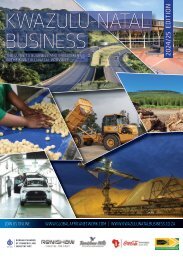Eastern Cape Business 2017 edition
The 2017 edition of Eastern Cape Business is the 10th issue of this highly successful publication that, since its launch in 2006, has established itself as the premier business and investment guide to the Eastern Cape Province. The Eastern Cape enjoys an abundance of natural and human resources, as well as established industrial infrastructure that drives the economy of the province. This includes three ports and two industrial development zones which are home to a wide range of manufacturers and exporters. The 2017 edition includes an in-depth look at the province’s two Industrial Development Zones, a focus on skills development and investment climate information from the Nelson Mandela Business Chamber and the Border-Kei Chamber of Business.
The 2017 edition of Eastern Cape Business is the 10th issue of this highly successful publication that, since its launch in 2006, has established itself as the premier business and investment guide to the Eastern Cape Province. The Eastern Cape enjoys an abundance of natural and human resources, as well as established industrial infrastructure that drives the economy of the province. This includes three ports and two industrial development zones which are home to a wide range of manufacturers and exporters.
The 2017 edition includes an in-depth look at the province’s two Industrial Development Zones, a focus on skills development and investment climate information from the Nelson Mandela Business Chamber and the Border-Kei Chamber of Business.
You also want an ePaper? Increase the reach of your titles
YUMPU automatically turns print PDFs into web optimized ePapers that Google loves.
OVERVIEW<br />
Water<br />
The <strong>Eastern</strong> <strong>Cape</strong> is tackling water shortages through new dams and improved controls.<br />
SECTOR INSIGHT<br />
The Umzimvubu Dam project<br />
will provide water and hydropower.<br />
• Rhodes University’s<br />
Institute for Water<br />
Research tests water<br />
quality.<br />
Water services are provided to the citizens of the <strong>Eastern</strong><br />
<strong>Cape</strong> by 17 water service authorities which oversee<br />
163 drinking water supply systems. Muncipalities and<br />
Amatola Water are the primary providers of services.<br />
Purification, desalination, water-leakage management and wastewater<br />
treatment are some of the problems facing the sector as a whole,<br />
and solutions are urgently needed. This is an important issue that<br />
entrepreneurs with good ideas would do well to tackle. According to<br />
Water Wheel magazine, 37% of water delivered to the nation’s municipalities<br />
is lost. This challenge presents an opportunity for companies<br />
who can find a solution, for example by providing better pipes and<br />
connections and smart metering.<br />
A water supply and hydropower project is underway on the<br />
Umzimvubu River. The R12-billion mega-project entails the construction<br />
of two multipurpose dams, Ntabelanga and Laleni Dams, on the<br />
Tsitsa River, which is a tributary of the Umzimvubu, to supply irrigated<br />
agriculture, domestic and industrial water requirements, and hydropower<br />
generation in the catchment area. The smaller dam at Tsitsa<br />
Falls will supply the hydropower<br />
element of the project.<br />
The Umzimvubu catchment<br />
and river system stretches for<br />
over 200km from its source in<br />
the Maloti-Drakensberg watershed<br />
on the Lesotho escarpment<br />
to Port St Johns. A large<br />
number of organisations and<br />
municipalities are in partnership<br />
to preserve the river system and<br />
surrounding catchment area. The<br />
river and adjacent forests, grasslands,<br />
thickets and dune vegetation<br />
are amazingly diverse but<br />
are threatened in various ways.<br />
The Umzimvubu Catchment<br />
Partnership Programme wants<br />
to find ways protect the environment<br />
while helping with poverty<br />
alleviation through the provision<br />
of water, erosion control and fodder<br />
for livestock and food security.<br />
Inter-basin water transfers are<br />
the norm in South Africa. In the<br />
1950s, the Orange River Project<br />
EASTERN CAPE BUSINESS <strong>2017</strong><br />
46


















